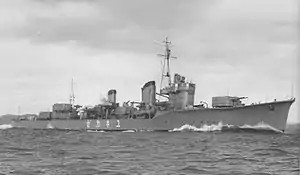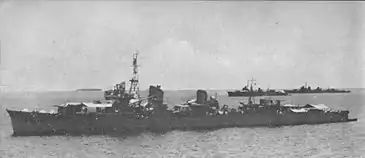Japanese destroyer Yukikaze (1939)
Yukikaze (雪風, "Snowy Wind") was a Kagerō-class destroyer in service with the Imperial Japanese Navy during World War II. She was the only member of her class to survive the war, and did so without suffering any major damage. Following the war, the ship was transferred to the Republic of China Navy, where she was renamed Tan Yang (丹陽) and served until 1966, before being scrapped in 1970.
 Yukikaze underway, December 1939 | |
| History | |
|---|---|
| Name: | Yukikaze |
| Builder: | Sasebo Naval Arsenal |
| Launched: | 24 March 1939 |
| Commissioned: | 20 January 1940 |
| Stricken: | 5 October 1945 |
| Fate: | Transferred to the Republic of China Navy, 6 July 1947 |
| Name: | ROCS Tan Yang (丹陽) |
| Acquired: | 6 July 1947 |
| Commissioned: | 1 May 1948 |
| Decommissioned: | 16 November 1966 |
| Fate: | Scrapped, 1970 |
| General characteristics | |
| Class and type: | Kagerō-class destroyer |
| Displacement: | 2,490 long tons (2,530 t) |
| Length: | 118.5 m (388 ft 9 in) |
| Beam: | 10.8 m (35 ft 5 in) |
| Draft: | 3.8 m (12 ft 6 in) |
| Speed: | 35 knots (40 mph; 65 km/h) |
| Complement: | 240 |
| Armament: |
|
Design and description
The Kagerō class was an enlarged and improved version of the preceding Asashio class of destroyers. Their crew numbered 240 officers and enlisted men. The ships measured 118.5 meters (388 ft 9 in) overall, with a beam of 10.8 meters (35 ft 5 in) and a draft of 3.76 meters (12 ft 4 in).[1] They displaced 2,065 metric tons (2,032 long tons) at standard load and 2,529 metric tons (2,489 long tons) at deep load.[2] The ships had two Kampon geared steam turbines, each driving one propeller shaft, using steam provided by three Kampon water-tube boilers. The turbines were rated at a total of 52,000 shaft horsepower (39,000 kW) for a designed speed of 35 knots (65 km/h; 40 mph). The ships had a range of 5,000 nautical miles (9,300 km; 5,800 mi) at a speed of 18 knots (33 km/h; 21 mph).[3]
The main armament of the Kagerō class consisted of six Type 3 127-millimeter (5.0 in) guns in three twin-gun turrets, one superfiring pair aft and one turret forward of the superstructure. They were built with four Type 96 25-millimeter (1.0 in) anti-aircraft guns in two twin-gun mounts, but more of these guns were added over the course of the war. The ships were also armed with eight 610-millimeter (24.0 in) torpedo tubes for the oxygen-fueled Type 93 "Long Lance" torpedo in two quadruple traversing mounts; one reload was carried for each tube.[2] Their anti-submarine weapons consisted of 16 depth charges.[3]
Construction and career
Imperial Japanese Navy
During the Pacific War, the attrition rate of Japanese destroyers was extremely high due to heavy, prolonged combat and the need to use them to transport supplies to scattered Japanese island garrisons. Early in the war, Yukikaze took part in the invasions of the Philippines and the Dutch East Indies. She participated in the battles of Midway, Santa Cruz, Leyte Gulf, and the Philippine Sea, as well as a lengthy stint on Guadalcanal troop runs and the naval battles around that island. Yukikaze also survived Operation Ten-Go, during which the battleship Yamato was sunk. Between these major engagements, Yukikaze participated in escort duty for ships in transit, particularly in the redeployment of the aircraft carrier Shinano during which the newly completed carrier was torpedoed by a U.S. Navy submarine and sunk. She spent the last months of the war on security duty in Japanese harbors and survived many Allied air raids.
As a result of participating in and surviving some of the most dangerous battles the IJN had fought, Yukikaze is very popular in Japan, being called "the unsinkable ship" and "the miracle ship" much like Shigure prior to that ship's sinking by the USS Blackfin. Yukikaze took part in more than 10 major battles, and more than 100 escort missions and resupply transport missions during World War II.
After the war, she was used as a transport to bring home Japanese military forces still abroad. Yukikaze, Ushio and Hibiki were the only ships to survive among the 82 Japanese destroyers built before the war.
ROCS Tan Yang

On 6 July 1947, Yukikaze was transferred to the Republic of China as a war reparation, where she was renamed Tan Yang (丹陽). All destroyers were named after Yang regardless of country of origin.
Tan Yang served as flagship of the Republic of China Navy, and between 1947 and 1953 was fitted with Type 89 12.7 cm/40 dual mounted guns, in addition to the Type 98 10cm/65 dual mounted guns already in use. In 1953, Tan Yang was refitted; all Japanese armaments were removed and replaced with three open air mounted 5"/38 caliber guns, 3"/50 caliber guns replaced the torpedo tubes, Bofors 40 mm guns, and newer depth charge launchers. The Republic of China Navy had no use for the original torpedo tubes as they did not have access to the appropriate armaments.
She is notable for visiting Manila where 50,000 overseas Chinese visited her. Tan Yang's service included patrolling the South China Sea and intercepting incoming ships carrying wartime materials into Shanghai. She also intercepted a Polish oil tanker (SS Praca), Prezydent Gottwald, and Soviet Tuapse carrying jet fuel into China between 1953 and 1954, and saw action along the Taiwan Strait in a supporting role as it was one of the few ships with long range guns. However, the arrival of surplus US destroyers entering service put the famous destroyer that once served as flagship into retirement, and she was scrapped in 1970 after being damaged beyond repair in a typhoon in 1969.
In Japan, there was a campaign to have her returned to Japan from Taiwan for preservation as a museum ship since she was the symbol for longevity. Her rudder and one of her anchors were repatriated to the Japan Navy Academy museum as a good will gesture.
Notes
- Chesneau, p. 194
- Whitley, pp. 200–01
- Jentschura, Jung & Mickel, p. 148
References
- Chesneau, Roger, ed. (1980). Conway's All the World's Fighting Ships 1922–1946. Greenwich, UK: Conway Maritime Press. ISBN 0-85177-146-7.
- Dodson, Aidan & Cant, Serena (2020). Spoils of War: The Fate of Enemy Fleets after Two World Wars. Barnsley, UK: Seaforth Publishing. ISBN 978-1-5267-4198-1.
- Jentschura, Hansgeorg; Jung, Dieter & Mickel, Peter (1977). Warships of the Imperial Japanese Navy, 1869–1945. Annapolis, Maryland: United States Naval Institute. ISBN 0-87021-893-X.
- Whitley, M. J. (1988). Destroyers of World War 2. Annapolis, Maryland: Naval Institute Press. ISBN 0-87021-326-1.